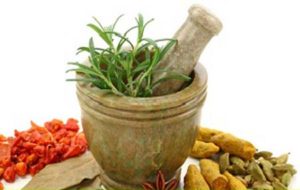Skin Care : Secrets from Ayurveda
The ancient healing tradition of Ayurveda is creating waves in the world of natural skin care. Industry leaders are touting the benefits of Ayurvedic herbs like Gotu Kola (Centella asiatica), and spas offering Ayurvedic rejuvenation therapies are sprouting up across the country.


According to Ayurveda Physicians, what you put on your skin is absorbed by your skin.
If you use heavily synthetic, chemical-laden products on delicate facial skin, be prepared for long-term damage. This doesn’t mean you have to do without cosmetics.
Look for natural products, and read those ingredients with a magnifying glass. Many products that claim to be “herbal” or “botanical” can contain artificial ingredients.
Ayurveda has sophisticated knowledge to offer in the realm of herbal approaches to skin care Ayurvedic formulations are often complex combinations of different types of herbs that offer the benefits of both synergy and balance, so that the final product is potent and highly effective without damaging side effects.”
Just incorporating an Ayurvedic herb or extract in a cosmetic product does not make it Ayurvedic. A herb can have powerful healing properties, but used alone or in inappropriate combinations, sometimes it does more harm than good.
Know Your Ayurvedic Skin Type
The first step in the holistic Ayurvedic approach to skin care is finding out your ayurvedic skin type. Vata, Pitta and Kapha are Ayurvedic psycho-physiological principles called doshas. They govern all the activities of the mind and body and determine the physical characteristics and emotional and mental tendencies of every human being.
These three principles are combinations of the five elements —
- Vata, for example, is mostly vayu and Aakash (air and space);
- Pitta is mainly Agni and jala (fire and water); and
- Kapha is primarily Prithvi and jala (earth and water.)
A person’s Ayurvedic skin type, therefore, can be Vata, Pitta or Kapha, or sometimes a combination of two of these doshas.
Further, a person can be born a certain skin type, but over time, that type may change because of external factors such as climate, diet and lifestyle habits or environmental pollution. Such “imbalances” should also be taken into account when choosing a skin care program.
Vata skin is in general dry, thin, cool to the touch, easily gets dehydrated, and is very vulnerable to the influence of dry, windy weather.
Pitta is mostly fire, so the Pitta skin type tends to have more breakouts, photosensitivity, less tolerance to hot food, and less tolerance to fieriness in temperament.
Pitta skin looks ruddy, and is warm to the touch. Pitta skin types tend to be more prone to freckles and moles than the other skin types.
Kapha dosha is predominantly water and earth, so Kapha skin tends to have all the qualities of water and earth — it can be greasy, thick, and more tolerant of the sun.
“Combination” skin can be Vata-Pitta, skin that is both dry and sensitive; Kapha-Pitta, or oily and sensitive skin; and Vata-Kapha, skin that is generally dry with some oily zones.
The ayurvedic approach to caring for combination skin takes into account environmental and seasonal factors.
For example, a person with Vata-Pitta skin would follow the recommendations for Pitta skin in summer and Vata skin in winter. The Kapha-Pitta type would follow Pitta recommendations in summer and Kapha recommendations in winter. The Vata-Kapha type would be best served by generally following Vata guidelines, with extra cleansing of the oily zones
Caring for Vata Skin
For Vata skin to stay youthful, skin care products used should be very nurturing. They must include some essential oils or herbs in combination which can nourish the skin and rehydrate it; otherwise, it may be susceptible to wrinkles and premature aging.
A Vata-pacifying lifestyle — like going to bed on time, eating three regular meals, and following a regular daily routine are essential components of a holistic approach to Vata skin care, as are eating foods that help balance Vata and nourish the Vata skin.
- Here are some suggestions for caring for Vata skin:
- Provide added nourishment to your skin by including organic milk, whole grains and green leafy vegetables in your diet.
- Drink lots of lukewarm water every day for internal hydration.
- Eat plenty of sweet juicy fruits; they help cleanse the body from within and provide hydration as well.
- Include a little healthy fat such as ghee (clarified butter) or olive oil in your diet for added lubrication.
- A warm oil self-massage (abhyanga) with a rich massage oil such as the bala taila, aswagandha taila etc are excellent for keeping skin lubricated.
Get plenty of rest so your mind as well as your body have the opportunity to recharge
Caring for Pitta Skin
The Pitta skin type needs both cooling and nurturing.
Use skin care products that help enhance resistance to the sun. Avoid tanning treatments and therapies that expose your delicate, sensitive skin to steam for extended periods of time.
The ayurvedic herb sariva, chandana, usheera, shatavari etc can help protect Pitta skin from photosensitivity.
But like other ayurvedic herbs, it needs to be used in combination with other herbs for a balanced effect on the skin.
To care for Pitta skin, follow these guidelines:
- Stay away from harsh, synthetic cosmetics; they can damage your sensitive skin and cause breakouts.
- Avoid hot, spicy foods and an excess of deep-fried foods; they add heat to an already fiery constitution.
- Eat lots of sweet, juicy fruits and have some gulkand and cool milk every day. The rose is considered cooling for mind, body and emotions.
- Use a cooling oil, such as the chandanadi tailam yashtimadhu tailam, for the daily massage.
- Cook with cooling spices such as fennel and licorice.
- Take extra care to protect your skin when you go out in the sun.
Kapha Skin Care
Kapha skin, because of its thickness and oiliness, is more prone to accumulate ama (toxins) under the skin.
People with Kapha skin need to do detoxification on a regular basis — both internal detoxification and external detoxification to flush toxins from the skin.
Scrubbing the skin with a gentle exfoliating clay such as bentonite clay with herbs can help external cleansing.
Kapha skin types may also need to take herbal formulations to cleanse the skin from within.
Some suggestions for caring for Kapha skin:
- Avoid too many sweet foods or deep-fried foods, as they add to the oiliness in the skin.
- Exercise every day to improve circulation.
- A daily warm oil massage can also help circulation. Oil containing shigru,rasna, lodhra can be used.
- Eat plenty of organic vegetables and fruits to help cleanse the body from within.
- Cleanse your skin twice every day; exfoliate with a mud-mask at least once a week.
- Cook with warming spices such as ginger and black pepper to stoke the digestive fire and inhibit the accumulation of ama inside the body.
True beauty comes from within – from good health and a happy soul. Pay attention to the health of your mind and body, and your friends will say “You look fabulous! What’s your secret?” certainly it’s Ayurveda.


Dr Chitra Mukul Gawande
Professor, SDM College of Ayurveda, Hassan Ph : +91- 8172- 2564 60, 61











